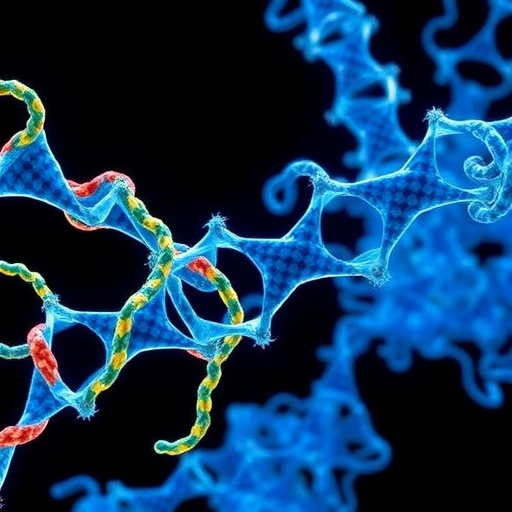Using cutting-edge methodologies derived from the field of biophysical chemistry, an interdisciplinary team led by Associate Professor Meredith Jackrel at Washington University in St. Louis has made a groundbreaking advance in visualizing a protein implicated in neurodegenerative diseases, specifically amyotrophic lateral sclerosis (ALS) and frontotemporal dementia (FTD). Their pioneering work, recently published in Molecular Cell, offers unprecedented structural insights into the Matrin-3 protein, which may hold the key to unveiling novel therapeutic avenues for these devastating conditions.
The research emerges from a concerted effort to discern the intricate behaviors of Matrin-3, a nuclear RNA-binding protein whose function is critical under healthy physiological conditions but known to misfold when mutated, contributing to neurodegeneration. Jackrel’s team, including lead author Dr. Macy Sprunger and collaborators from both the Department of Chemistry and the McKelvey School of Engineering, exploited advanced electron microscopy combined with biochemical refinement techniques to characterize these elusive protein assemblies at a molecular resolution previously thought unattainable.
Matrin-3’s role extends beyond simple nucleic acid regulation; it influences cell survival, differentiation, and gene expression patterns. However, mutations within the Matrin-3 gene have demonstrated a propensity for inducing protein misfolding, which disrupts normal cellular homeostasis. These aberrant protein conformations progressively impair neuronal function, contributing to the pathophysiology of ALS and FTD, diseases characterized by the degeneration of motor neurons and frontal-temporal brain regions, respectively.
One of the formidable challenges the researchers faced involved the isolation of Matrin-3 in a purified state from the complex milieu of cellular proteins. This purification was critical for creating a clean system to observe the protein’s native and mutant forms under various experimental conditions. Sprunger’s perseverance over two years of experimentation culminated in a robust isolation method that enabled subsequent high-resolution imaging and biochemical assays.
Employing state-of-the-art cryo-electron microscopy, the team visualized distinctive structural assemblies formed by Matrin-3. The proteins displayed an intriguing morphological transition from nanoscale spherical condensates into elongated worm-like formations. This dynamic structural transformation hinted at previously unrecognized phase behaviors critical to understanding the protein’s functional repertoire and misfunction in disease contexts.
The team’s collaboration with Professor Rohit Pappu and postdoctoral researcher Min Kyung Shinn, both experts in biomolecular condensates, elucidated that the spherical-to-worm-shaped transition likely proceeds via microphase separation, a biophysical phenomenon where macromolecules form mesoscale domains controlled by molecular interactions and thermodynamic principles. This discovery introduces a novel conceptual framework for the behavior of RNA-binding proteins implicated in neurodegeneration.
Experiments further demonstrated that the presence of RNA strongly influenced the assembly dynamics of non-mutated Matrin-3 proteins, causing a significant decrease in worm-like assembly lengths. This RNA-mediated modulation underscores Matrin-3’s intimate functional relationship with nucleic acids and implies a regulatory mechanism that governs protein assembly morphology via RNA interactions.
Intriguingly, Matrin-3 variants harboring disease-related mutations did not exhibit the same responsiveness to RNA. Their worm-like structures remained rigid and persistently elongated despite the addition of RNA. This apparent resistance to structural remodeling may exacerbate pathological aggregation and dysfunction, suggesting a molecular basis for how mutations contribute to the progression of ALS and FTD at a biophysical level.
The implications of these findings are profound. By establishing reliable protocols for Matrin-3 purification and characterizing its phase behavior at the nanoscale, Jackrel’s lab paves the way for mechanistic studies to uncover how these protein assemblies interfere with neuronal function. Such knowledge is essential for designing therapeutic strategies aimed at modulating protein phase behavior or stabilizing its functional conformations.
Moreover, this study hints that microphase separation is not unique to Matrin-3 but may represent a widespread, yet underexplored, mechanism in cellular organization and protein aggregation pathology. The small size of these protein assemblies has historically limited detailed study, but the team’s advances in imaging and biochemistry open new frontiers to explore condensate biology in neurodegenerative diseases.
Jackrel acknowledged the critical role Sprunger’s relentless optimization played in overcoming technical obstacles. The successful purification and real-time imaging of these assemblies in living cells mark substantial progress toward decoding the molecular etiology of ALS and potentially other linked neurological disorders. Future work promises to delve deeper into the molecular triggers and consequences of phase behavior alterations induced by pathological mutations.
The convergence of molecular biophysics, advanced microscopy, and neurobiology exemplified in this research underscores a transformative approach to tackling diseases rooted in protein misfolding and aggregation. By dissecting the physical principles governing Matrin-3 assembly, the team provides hope that targeted therapeutic interventions might one day stymie or reverse the course of ALS and FTD, effects that have eluded modern medicine to date.
As the study progresses, Jackrel’s lab intends to expand its scope to investigate how widespread microphase separation phenomena contribute to cellular function and dysfunction more broadly. This could usher in a paradigm shift in understanding proteinaceous biomolecular condensates’ roles, expanding from fundamental cell biology to disease mechanisms.
In conclusion, this pioneering research delivers a clarion call for the integration of sophisticated biophysical tools in unraveling the molecular underpinnings of neurodegenerative disorders. It offers a beacon of promise that the microbial-scale structural transitions uncovered in Matrin-3 could illuminate new paths for diagnosis, treatment, and prevention of ALS and FTD.
Subject of Research: Characterization of Matrin-3 protein assemblies and their role in ALS and frontotemporal dementia through advanced biophysical chemistry techniques.
Article Title: [Not provided in the source text]
News Publication Date: [Not provided in the source text]
Web References: https://chemistry.wustl.edu/people/meredith-jackrel, https://www.cell.com/molecular-cell/fulltext/S1097-2765(25)00740-3
References: Jackrel, M., Sprunger, M., Talir, S., Lee, K., Shinn, M. K., Pappu, R., et al. “Structural characterization of Matrin-3 protein assemblies associated with neurodegeneration.” Molecular Cell. [Full citation details unavailable].
Image Credits: [Not provided]
Keywords
Neurological disorders, Amyotrophic lateral sclerosis, Alzheimer disease, Protein functions, Neurodegenerative diseases




